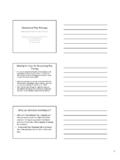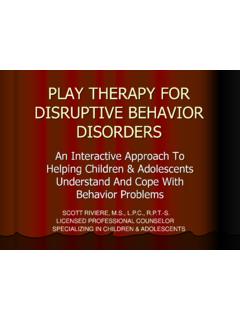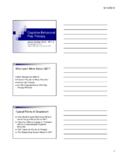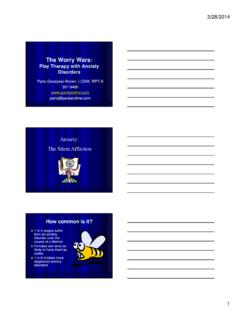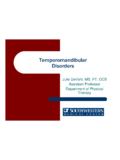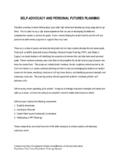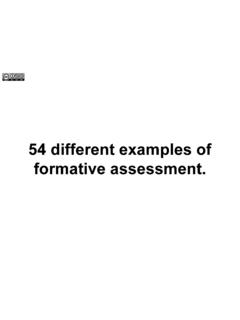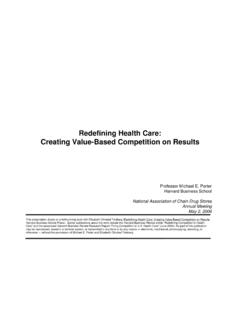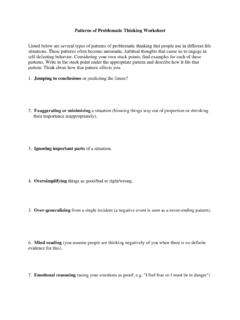Transcription of EMDR with Children.ppt
1 EMDR with children Renee Yoelin-Allen LCSW RPT/S. April 2013. Overview Trauma and the impact on brain development General understanding of EMDR- 8 stages and Play Therapy adaptations Adaptive Information Processing Model Francine Shapiro AIP model, like other learning theories, postulates the existence of an information processing system that assimilates new experiences into already existing memory networks. These networks are the basis for perception, attitudes and behavior behavior. Current situations are automatically linked to the association networks. (Buchnanon). Distressing incidences may become stored in the state- specific form, frozen in time in it's own neural networks unable to connect with other memory networks that hold adaptive information.. 1. Dysfunctionally stored memories lay the foundation for future maladaptive responses. AIP views negative behavior as a result of dysfunctionally held In disconnected memory pathways.
2 Pathology is viewed as a result of unprocessed experiences. Health is viewed as integrated memory networks- forging new associations and connections enabling learning to take place with the memory stored in a new adaptive forms What does that mean for our kids? Amygdala: Evaluation of the emotional meaning of incoming stimuli. Hippocampal system: Storage of incoming stimuli in memory. evaluation of spatially and temporally unrelated events, comparing them with previously stored information and determining whether and how they are associated with each other other The slow maturation of the hippocampus, which is not fully myelinated till after the third or fourth year of life, is seen as the cause of infantile amnesia. Serotonin: Studies of impulsive, aggressive and suicidal patients seem to find a robust association between those behaviors and histories of childhood trauma and a decrease in serotonin Autonomic System- Polyvagal System- allows adaptation and flexibility to their environments- and connect with others.
3 Porges(2011) Defines psychopathology h th l as th the persons' inability to inhibit defense system in a safe environment and the inability to activate the defense sx in the presence of danger. The inaccurate assessment of safety and danger may lie at the core of the difficulties experienced by children 2. Traumas: BIG T or little t . Type I Trauma and Type II Traumas Causes How kids look Type I- single incident Type II- chronic EMDR research Approximately 7 controlled randomized studies and d 10- non-randomized studies with children found that EMDR. therapy is effective in reducing PTSD. symptoms and disaster related stress symptoms. Research with randomized subjects with PTSD for 8. weeks of treatment. Bessel A. van der Kolk, Early Trauma changes the brain- chemically, neurons, learning, memory, capacity, effectiveness, efficiency and structurally. At 6mo follow-up p 75% of adult onset trauma vs.
4 33% of child onset receiving EMDR achieved asymptomatic. None for Prozac. Most childhood onset trauma subjects , neither tx produced complete sx remission. Who wants to do research?..seriously 3. PTSD is an anxiety response (disorder?). A learned response to traumatic experiences He started it . Kids perceived threat- hyperarosal- Teachers', parents' and peers' comments, corrections or directions can trigger trauma response instantaneously. The child's brain has over generalized and reacts with dysregulation: fight, flight or freeze. Opportunity for learning is lost until calm state has returned. No Frontal Lobe available. Teach and practice self-regulation skills in a calm state- not during Sensory Processing Disorder . Inability to use information from senses to function (visual, auditory, gross and fine motor and taste). Sensory Modulation Problems: How the child regulates his response to sensations.
5 Making the distinction and comorbidity ??? Adding OT? 4. It's in! it doesn't matter who you are; our physiologically stored memories are the basis of our currently perceptions of the present. Unprocessed memories not only can intensify our sensations and emotional responses, they can prevent us from feeling. F. Shapiro EMDR 8 Phases History and Tx Planning Preparation 3 pronged Assessment Past Desensitization Present P t Installation Future Body Scan Closure Not a linear Re-evaluation process Phase 1: History and Tx Planning Child Trauma Screening Questionnaire What gets in the way? How? When Wh did it start? t t? What would it be like if you didn't have Why do your parents want you here? Guess? 5. Family Window of affect tolerance What happens when exceeded- parent and child Parent acts as external regulator Developmental Expectations Emotional availability Trauma hx What has worked-even once Time line Pregnancy------------------------------- -------------Now Identified traumas Births t s Deaths Moves School Siblings Deployments Medical Separations Child Begin listening for NC.
6 Affect tolerance Avoidance Nightmares Internal and external resources PC and comfort place Robin Adler Tapia 6. Relationship Relationship based on acceptance, empathy and safety set the foundation for connection. (Siegel). Boundary setting and responses Competitive Dysfunctional, dsyregulating relationship needs to be repaired Frequency, Intensity and Duration What is the most difficult/concerning/troubling/interferi ng behaviors? How often? How big? 10. For how long? 8. How will you know there is 6. improvement?? 4. What bothers you the most? 2. 0. nightmares frozen hand washing Phase 2 - P r e p a r a t i o n Primary Goals Resource Development Teach, practice and achieve some mastery t off selflf and d family f il regulation Explore the child's ability to tolerate negative and positive affect. Window of Tolerance. 7. Safe place-containers-resource development and installation. Build, repair and reinforce neuro- pathways p y for ppositive and safe connections.
7 The more complex the trauma and/or the less family support the more time spent here. Explore positive, regulating and attuned interactions. Create and practice self regulation and a new body sense. Preparation Phase ongoing throughout therapy. Kids want to know . Brain parts How they work together, keep us safe and learn. Stuck thoughts and quick reactions reactions. Build new roads. Brain muscle training. Give it some air baby. Tiger in the room. Walking a trail. and they get it. 8. Seek familiar vs. Helpful Ah HA- I knew it !! Working the stuck muscle Comfort Place Reprocessing trauma See, Hear, Temp, without a safe back Body sensations, drop will not be Taste, Emotions and affective. Child may SMELL. become beco e flooded. ooded Message to self Breathe BLS. 9. Practice Title- one word access Object Picture Jewelry-toy-animal Pillow case Song Experience within play Self-Regulate Healing Light Muscle tension Butterfly B tt fl Move activate Limbic Sx Energy Psychology and Emotional Freedom Technique EFT.
8 Gary Craig Energy Psychology and EMDR: Hartung and Galvin Tapping for Trauma: Heart Math TAT Tapas Acupressure Technique 10. Container Prep and unfinished sessions Bag, Box, jar, suit case, trash can . Secure? Placement Real or imagined Enhanced- Resources and Practice Reprocessing trauma cannot occur if the adaptive and positive pathways aren't there. Emotional vocabularyy Prescribe nurturing routines Start with positive Experiences within play tx Nurturing parent touch- avoid flooding Short -avoid accessing upsetting material Light touch, warmth and sense of comfort, increases oxytocin and endorphins that enhance social bonds through g association with feelings of well being. Increases cortisol receptors- allows for uptake that prevents flooding. Cozilino (2006). 11. What are we doing here? Ride a bike or scooter Going to the Pool Working new brain muscles Video Just Visiting Let your brain do the work Questions are for more information not because it's not right.
9 Building Internal Resources Bubble and shields Supporter Heroes Animals Role play positives What didn't you say? PET scans show that individuals dx with PTSD- during recall of traumatic events show significant g decrease in Boca's area. These finding point to the inability of traumatized individuals to use words when experiencing deregulated affective states. Show me-move, dance, statue, walk Draw 12. The research and experts Stimulating the Rt and Lt side of the brain through play and games that promote participation, creates the stage for the rapid processing and assimilation of t trauma memories- i Siegel Affect labeling improves neural regulation Cresswell Use Lt language centers to calm the excessively firing Rt emotional areas. Pankseep Link not replace Positive Cognitions Games Ball Bean bag g Heartmath PC Cards and feeling faces Limit selection Pictures of self- feeling wheel Timeline Chronological First Today Location Worst Lifetime What gets in your way Event specific Memory detector 13.
10 Titrate-affect tolerance State change Self regulate Resources in tool box Limit processing container Still Prep Extension of Preparation Play with EMDR skills Role play games Familiar process and language Emotional and Physical Awareness Affect tolerance Identify Targets Negative Cognition List What mixed up thoughts or something yucky you learn about yourself when . Volume, face, body What do you tell yourself about yourself What names do you call yourself When was the 1st or worst 14. How Much? Hands Number line HAP. Draw own Pictureof self Continuum of feelings- Your in State Changes Start with 2-3. Role Play Freeze- Freeze Regulate! Double duty Jump Phase 3 - Assessment Access memory network with trauma Activatecog., affect and somatic aspects t off memories i Baseline for VoC and SUD. 15. Access and Connect Parasymathic and Sympathic System Dissociation Avoidance (Some) Chronically traumatized children automatically responds to minor environmental challenges by collapsing and surrendering (Levin).
